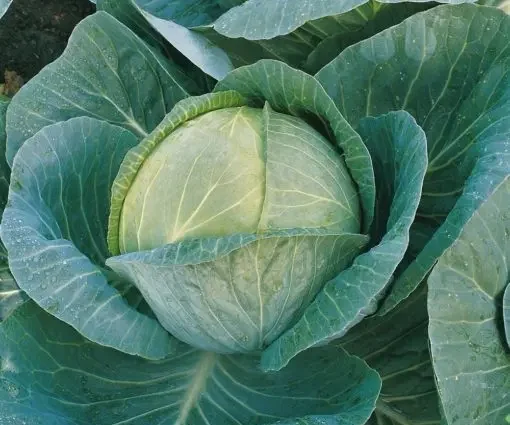Contents
Many gardeners are engaged in the cultivation of various varieties and varieties of cabbage. A vegetable from its own garden is valued for its environmental friendliness. After all, it is no secret to anyone that when growing cabbage in large farms, they use a lot of fertilizers, as well as chemicals to fight diseases and pests.
Choosing a variety for summer residents is an important point, because high-yielding and disease-resistant plants are required. White cabbage Megaton meets all the requirements, does not cause any particular difficulties in leaving. Description, characteristics of the variety and interesting photos can be found in our article.
Patrimony
The first to describe the cabbage variety Megaton were its creators, Dutch breeders from the seed company Bejo Zaden. They managed to get such a hybrid of white cabbage, which combines in its characteristics the requirements of many agricultural producers:
- large and elastic heads of cabbage;
- high immunity to diseases and pests;
- ability to withstand adverse weather conditions;
- average terms of maturing;
- the ability to preserve the crop for a long time.
On the territory of Our Country, the variety has been allowed for cultivation since 1996, after being included in the State Register. Megaton cabbage is not recommended for cultivation in some regions of the Middle Volga region:
- Republic of Mordovia;
- Tatarstan;
- Penza region;
- Samara region;
- Ulyanovsk region.
Gardeners who have been growing white cabbage Megaton for more than one year, in their reviews, put “five” to breeders from Holland.
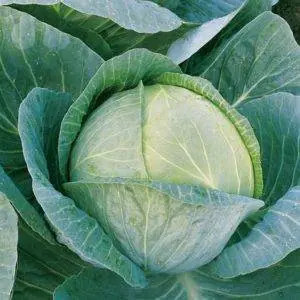
Description of the cabbage variety
When choosing seeds for planting white cabbage, vegetable growers pay attention to the variety description, cultivation features. Every detail is important to them. Let’s deal with these questions.
The cabbage variety Megaton F1, according to the characteristics and reviews of gardeners, is mid-season. From the moment of sowing seeds to technical maturity, it takes from 136 to 168 days.
The leaves of the Dutch hybrid have large rosette sizes. They can be horizontal or slightly raised. The edges of large, rounded leaves are concave with a noticeable waviness, light green, matte due to a wax coating. Integumentary leaves with wrinkles.
The forks are large, round in shape and dense in structure. Many gardeners, noting this feature, write in reviews that Megaton F1 white cabbage is as hard as a stone in technical maturity.
On a small inner stalk about 15 cm long, heads of cabbage weighing 3-4 kg grow. But with good care, compliance with all agricultural standards, some gardeners receive forks of 10-15 kilograms. On the cut, the cabbage is snow-white, as in the photo below.
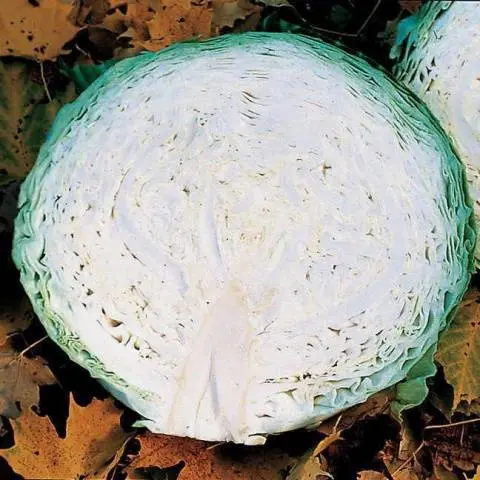
White cabbage Megaton, according to the description of the variety, reviews of gardeners who have been growing for a number of years, is very tasty and healthy. It contains a large number of substances necessary for humans. Here are some numbers for 100 grams of raw cabbage:
- protein – 0,6-3%;
- ascorbic acid 39,3-43,6 mg;
- sugar from 3,8 to 5%;
- dry matter from 7,9 to 8,7%.
Characteristics of cabbage
Although not much time has passed since 1996, not only gardeners have fallen in love with the Megaton F1 cabbage variety, but it is also grown on a large scale by farmers for sale.
Let’s find out what are the benefits of this white vegetable:
- Excellent taste, cabbage is juicy and crunchy, the hybrid is most suitable for sauerkraut.
- The variety is high-yielding, from 586 to 934 centners can be harvested per hectare.
- Megaton F1 is resistant to many diseases that usually affect other varieties and varieties of cabbage: Fusarium wilt, clubroot, gray rot. Some pests also “bypass” the forks.
- Unfavorable weather conditions do not negatively affect the quality of heads and yields: prolonged rains do not lead to cracking.
- White cabbage is valued for its transportability and the possibility of storage after cutting for three months.
We considered the positive points, but Megaton F1 white cabbage also has some disadvantages:
- in the first days after cutting, the leaves of the variety are harsh;
- the presence of a large amount of sugar does not allow the preparation of salads and cabbage rolls from the leaves;
- many gardeners are confused by the short, in their opinion, shelf life.
If you look at the ratio of pros and cons, then you should buy seeds and try to grow Megaton F1 cabbage in your area.
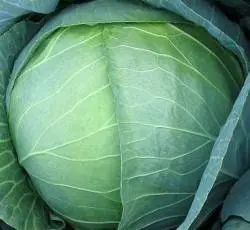
How to grow seedlings
If you have made a choice, buy Megaton cabbage seeds only in specialized stores. In this case, you can be sure of the quality and germination. After all, the seeds, unfortunately, are not cheap.
So, the seeds are purchased, you need to sow seedlings. The fact is that Megaton cabbage, according to the characteristics and description, is grown only in seedlings. Since the variety is medium late, the seeds for seedlings are sown in late April, early May.
Preparing seeds for planting
To grow healthy seedlings of Megaton cabbage and get tight heads of cabbage, and not shaggy “brooms”, the seeds should be specially prepared.
Let’s consider the stages:
- The water is heated to 50 degrees and the seeds are lowered for a third of an hour. It is best to put them in a cloth bag. After that, they are transferred to cold water.
- The next step is soaking in Epin or Zircon for several hours. You can also use a solution of nitrophoska for soaking. After the procedure, the seeds must be rinsed with clean water and dried.
- Sowing material should be hardened three days before sowing. The ideal place for this is the bottom shelf of the refrigerator. This procedure will increase the resistance of plants to small frosts.
Sowing seeds and caring for seedlings
Fertile soil is poured into the seedling box and mixed with wood ash. Pour boiling water over the soil, dissolving potassium permanganate in it. When the soil has cooled to room temperature, furrows are made in increments of 6-7 cm. Seeds are placed in them at a distance of 3-4 cm, to a depth of 3 cm. If picking seedlings is not included in the plans, the distance between future seedlings should be increased. A film is stretched from above to speed up the shoots.
As a rule, cabbage seeds germinate in 3-4 days. Since the seedling box is on the street, the film or glass is not removed so that heat remains inside. On hot days, the shelter is raised so that the seedlings do not burn out, and there is access to fresh air.
During the growth of seedlings, it must be watered with warm water, weeding. It is useful to sprinkle small cabbage with wood ash. She repels the cruciferous flea.
Many gardeners dive seedlings into separate containers. Such work should be carried out when 2-3 true leaves are formed. The soil is selected fertile, treated with boiling water.
After removing the plant from the nursery, cut the root by a third. This will ensure the development of a fibrous root system. Planted cabbage of the Megaton F1 variety can be placed in a greenhouse or under a temporary film shelter. The main thing is that there is good lighting, and at night the plants do not get frost.
The first weeks of cabbage seedlings require special attention. It is necessary to constantly loosen the earth, remove weeds, water moderately. After all, it is at this time that the future harvest is formed. Only strong seedlings can tie tight heads of cabbage.
Bedding
Before planting in open ground, seedlings should be tall (15 to 20 cm), with a thick stem and 4 to 6 leaves. Megaton cabbage is planted around the end of May. Although the dates are approximate, it all depends on the climatic conditions of the region.
Ridges for planting Megaton cabbage have been prepared since autumn, choosing an open sunny place for this. It is important to remember that cabbage is not grown on those ridges where cruciferous plants grew. It is best to plant cabbage after legumes, carrots, onions. In autumn, the ridges are cleaned of plant residues, rotted manure is added (mineral fertilizers can be used) and dug up.
In spring, you can not dig up the soil, but immediately make holes at a distance between plants of at least 50-60 cm. For ease of care, Megaton cabbage, according to the variety description, is planted in a two-row way, as in the photo below.
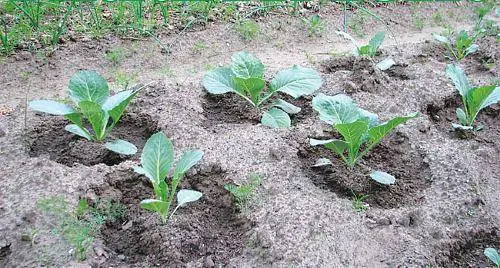
Plants are taken out of the ground, gently inserted into the hole, directing the roots straight down. When seedlings fall asleep with earth, they are guided by the first true leaf. It should rise above the surface. Water the cabbage immediately after planting.
Care for cabbage
Further care for the Megaton variety is:
- In abundant watering. At least 15 liters of water are poured onto the square, especially in dry summers. But the soil should not be waterlogged so that the roots do not rot. It is useful in dry weather to use a sprinkling plant for watering Megaton cabbage (turntables are sold in all stores).
- In weeding, loosening and hilling up to the closing of the lower leaves and mulching with peat.
- In regular feeding. The first time they feed the cabbage immediately after planting in the ground with potash fertilizers and saltpeter. The second top dressing with nitrogenous fertilizers falls at the time of fork formation. The third – after 21 days with nitrogen-containing and phosphorus fertilizers. When using mineral fertilizers, carefully read the instructions for use.
- In the fight against pests and diseases. Although according to the description, as well as, according to the reviews of gardeners, the Megaton cabbage variety is resistant to many diseases and is almost not affected by pests, preventive treatments will not interfere. After all, as a rule, one variety of cabbage is not limited. From pests such as cabbage aphids, whiteflies, cabbage moths, the immune system is unable to cope on its own. Yes, and spores of fungal diseases can get into the area with rain or wind.
Megaton cabbage harvest is harvested after the first frost. Until this time, the leaves should not be cut off, so as not to reduce the yield of the beds. By the time of cutting, the cabbage becomes tight, barely holding on to the stalk. Sometimes you have to put something under it.
A white vegetable is cut in dry weather, the leaves are cut off and laid out in the sun to dry. Cabbage is stored until salting in a place protected from rain and frost. Our readers are often interested in how long Megaton cabbage can be salted. If you re-read the description of the variety, then it clearly states that immediately after cutting the leaves are harsh. By the time of salting for the winter, they will just arrive in time.
About cabbage Megaton:










